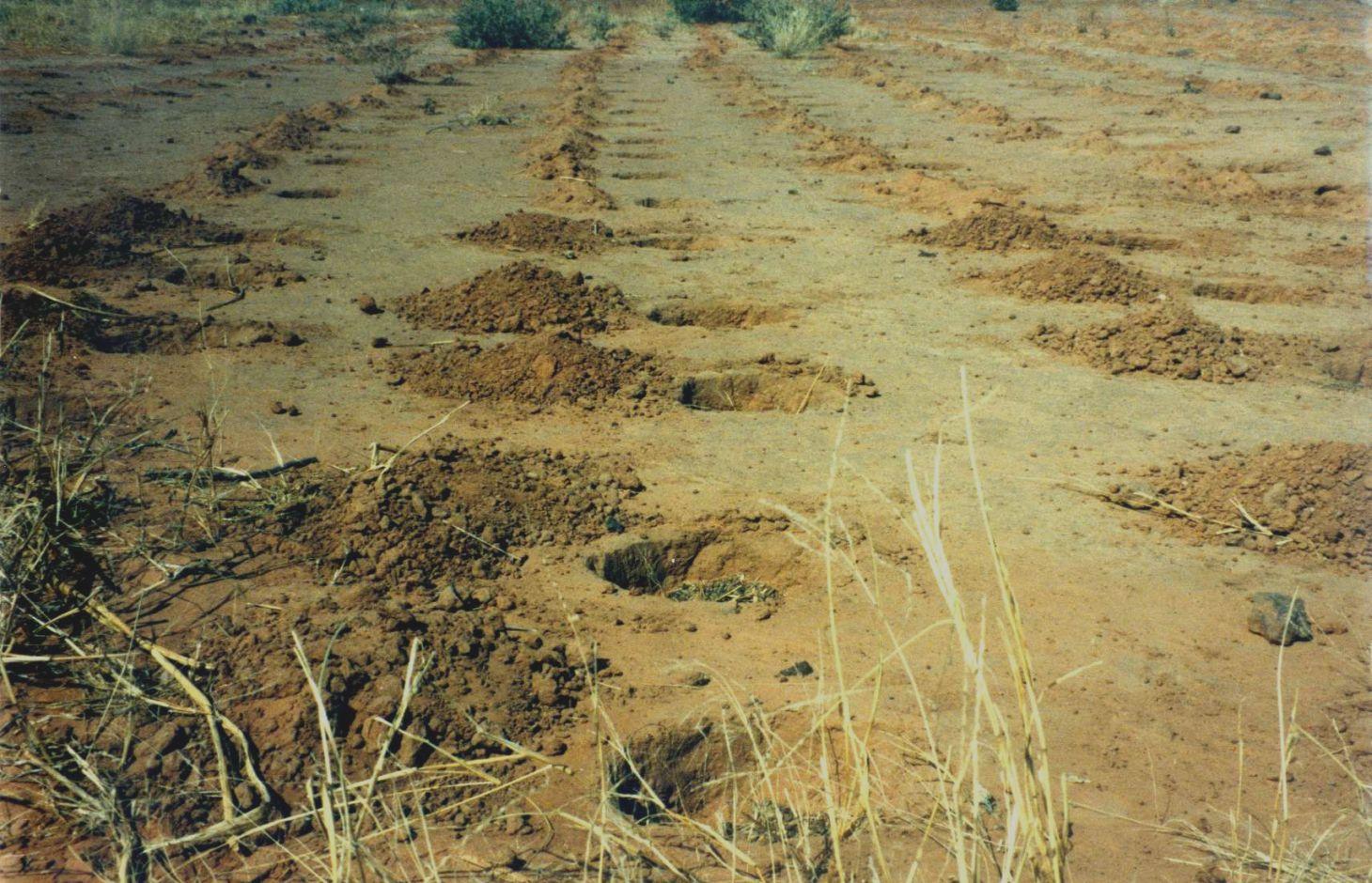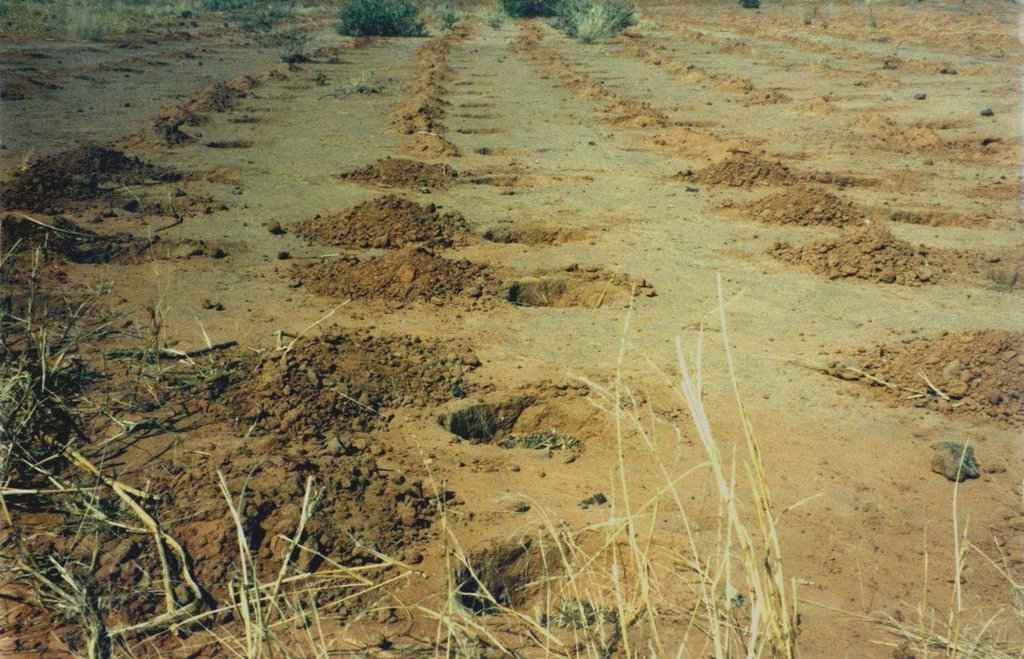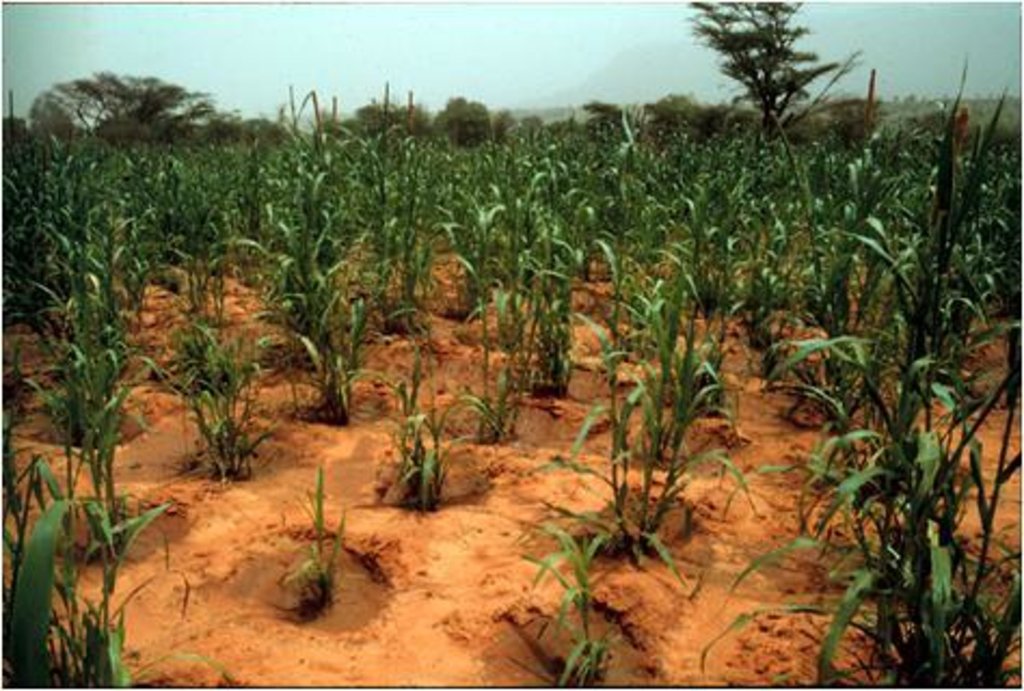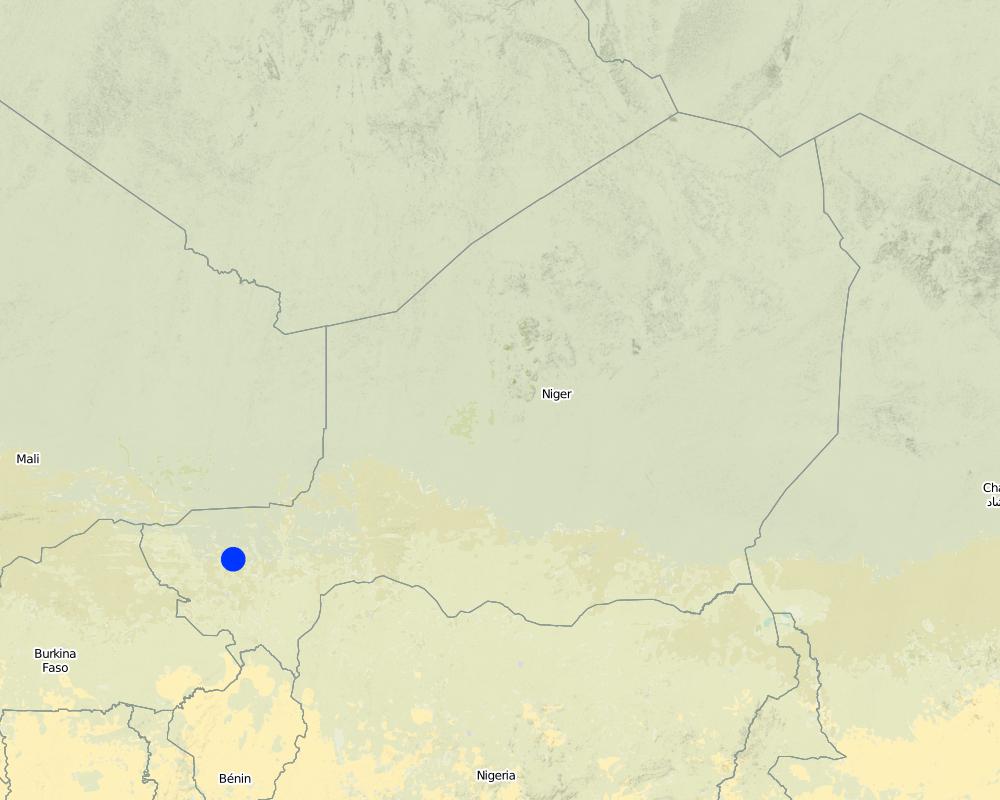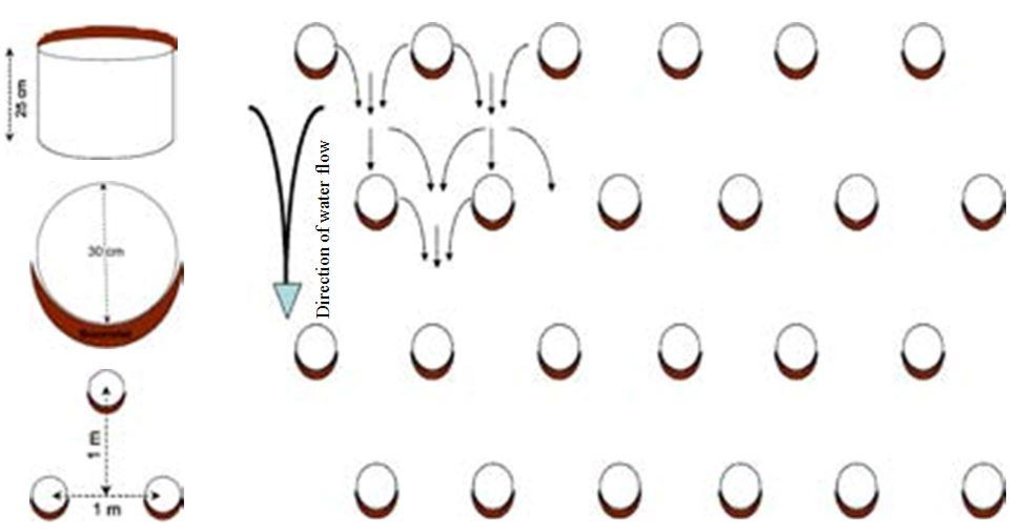Zai or tassa planting pits [Нигер ]
- Шинийг нээх:
- Шинэчлэх:
- Мэдээлэл цуглуулсан: Dieter Nill
- Редактор: –
- Хянагчид: Alexandra Gavilano, Deborah Niggli, Nina Lauterburg, Fabian Ottiger
Zaï - Tassa (French)
technologies_1219 - Нигер
Бүлгүүдийг үзэх
Бүгдийг харуулах Бүгдийг хаах1. Ерөнхий мэдээлэл
1.2 Технологийг үнэлэх, баримтжуулах ажилд хамаарах мэдээлэл өгсөн хүмүүс, байгууллагуудын холбоо барих мэдээлэл
ГТМ мэргэжилтэн :
Dorlöchter-Sulser Sabine
Misereor
Герман
ГТМ мэргэжилтэн :
Mamadou Abdou Sani
Programme d’Appui à l’agriculture Productive (PROMAP)/GIZ
Нигер
Технологи баримтжуулах/үнэлэх ажилд дэмжлэг үзүүлсэн төслийн нэр (шаардлагатай бол)
Manual of Good Practices in Small Scale Irrigation in the Sahel (GIZ )Технологи баримтжуулах/үнэлэх ажилд дэмжлэг үзүүлсэн байгууллага(ууд)-ын нэр (шаардлагатай бол)
Deutsche Gesellschaft für Internationale Zusammenarbeit (GIZ) - ГерманТехнологи баримтжуулах/үнэлэх ажилд дэмжлэг үзүүлсэн байгууллага(ууд)-ын нэр (шаардлагатай бол)
Misereor - Герман1.3 WOCAT-аар баримтжуулсан өгөгдлийг ашиглахтай холбоотой нөхцөл
Эмхэтгэгч болон гол мэдээлэгч хүн(хүмүүс) WOCAT аргачлалаар баримтжуулсан мэдээллийг ашиглахтай холбоотой нөхцлийг хүлээн зөвшөөрсөн.
Тийм
1.4 Технологи тогтвортой гэдгийг баталгаажуулах
Энэ технологи азрын доройтлыг бууруулахад нөлөө үзүүлэхгүй тул газрын тогтвортой менежментийн технологи болж чадахгүй юу?
Үгүй
2. ГТМ Технологийн тодорхойлолт
2.1 Технологийн товч тодорхойлолт
Технологийн тодорхойлолт:
Zai planting pits are designed to collect rainwater and to conserve nutrients in order to improve crop production and food security.
2.2 Технологийн дэлгэрэнгүй тайлбар
Тодорхойлолт:
Zai or tassa planting pits are an old farming technique rediscovered after the great drought of 1973/74 and later perfected by development partners working with the farmers. It involves digging planting pits with a diameter of at least 30 to 40 cm and 10 to 15 cm deep. They are spaced 70 to 80 cm apart, resulting in around 10,000 pits per hectare. Staggered rows of holes are dug perpendicularly to the slope. The earth dug out of the hole is piled up to form a small ridge around the rim, which captures water. A couple of handfuls of organic fertiliser or compost are put into each pit. They are normally made in the dry season before the first rains start. However, it is recommended that the pits be made immediately after the rainy season, when the soil is still moist and the weather is not too hot. If the pits are in place early in the dry season, they act as traps during the windy period in February and March, retaining rich dust carried by the harmattan and wind-blown organic matter. At least 3 tonnes of compost per hectare is recommended.
Purpose of the Technology: The arrangement of the pits in staggered rows ensures the most efficient collection of rainwater and slows the flow of water over the surface. The zai technique concentrates and conserves nutrients and water near the roots of the plants grown in them. The application of organic fertiliser directly around the plants is an economical use of a factor of production to which most farmers have limited access. It also reactivates biological activity, increases fertility and loosens the soil.
As zai planting pits restore degraded, uncultivated land, they lessen the pressure to clear other land for farming. They also reduce the vulnerability of plants during dry spells and droughts, ensuring crop production and improving food security.
Plots with zai planting pits (with fertiliser) average yields of 409 kg of millet grain per hectare, compared to 195 kg per hectare registered on control plots. Millet yields can therefore be doubled with this technique.
Establishment / maintenance activities and inputs: The zai technique requires high labour input. It is estimated that between 40 and 60 man-days per hectare are required, depending on the density of the pits. There is a mechanised system for making the holes, using a special animal-drawn plough, which considerably reduces the number of man-days required to 7 per hectare.
If the pits are prepared each year or once every two years (using the same pits or making new ones in the spaces between the old ones), soil fertility is restored and the crop cycle can be resumed. The application of organic fertiliser in sufficient quantities enables the plot to be cultivated sustainably. After five years, it can be farmed in the normal way.
Covering extensive areas with zai planting pits requires a high level of community mobilisation and effective organisation and logistics. Apart from this, the technique is very simple to implement and easily mastered by the farmers.
Natural / human environment: Zai planting pits are used on marginal or degraded land that is no longer cultivated, such as low-gradient pediments and land with encrusted soil in areas with rainfall levels of less than 800 mm a year. They are not recommended for sandy soils, as they are not stable when dug in this type of soil, or for valley bottoms, where they risk being flooded. Zai planting pits are particularly useful in areas where land use pressure is high, as they permit the rehabilitation of unproductive land for farming.
From the point of view of climate change adaptation, zai planting pits are particularly useful in areas with erratic or low rainfall, as they prevent the loss of water. As the fertiliser is placed inside the pits, it is not washed away by heavy rain.
2.3 Технологийн гэрэл зураг
2.5 Энэ үнэлгээнд хамрагдсан технологийг хэрэгжүүлсэн улс орон / бүс нутаг / байршил
Улс :
Нигер
Улс/аймаг/сум:
Niger
Байршлын дэлгэрэнгүй тодорхойлолт:
Regions of Tillabéri, Filingué, Ouallam, Téra and Tahuoa
Map
×2.6 Хэрэгжих огноо
Байгуулсан тодорхой оныг мэдэхгүй бол баримжаа хугацааг тодорхойл:
- 10-50 жилийн өмнө
2.7 Технологийн танилцуулга
Технологийг хэрхэн нэвтрүүлснийг тодорхойл:
- Гадны төсөл/хөтөлбөрийн дэмжлэгтэйгээр
Тайлбар (төслийн төрөл г.м.):
developed, implemented and disseminated as part of projects and programmes undertaken from the 1980s onwards to combat desertification and improve natural resource management. Implemented by GIZ (German Federal Enterprise for International Cooperation), PDRT (Projet de développement rural de Tahoua - Tahoua Rural Development Project), PASP (Projet de protection intégrée des ressources agro-sylvo-pastorales Tillabéri-Nord - Project for the Integrated Protection of Agricultural, Forest and Rangeland Resources in Tillabéri-Nord)
3. ГТМ технологийн ангилал
3.1 Технологийн үндсэн зорилго (д)
- Үйлдвэрлэлийг сайжруулах
- Үр ашигтай эдийн засгийн нөлөөг бий болгох
3.2 Технологи хэвтрүүлсэн газрын одоогийн газар ашиглалтын хэлбэр(д)
Нэг газр нутгийн хэмжээнд хэрэгжих холимог газар ашиглалт:
Тийм
Газар ашиглалтын холимог тогтолцоог (тарилан/бэлчээр/ой мод) тодорхойл:
- Агро-сильво-пасторализм

Тариалангийн газар
- Нэг наст үр тариа
- Мод, бут тариалах
Тариалан - Таримлыг тодорхойлно уу:
- тосны ургамал - газрын самар
- үр тариа - шар будаа
- үр тариа - жирийн сорго
- буурцагт ургамал - вандуй
Мод, бут тариалах - Таримлыг тодорхойлно уу:
- манго, давжаа манго, гуав
Нэг жил дэх ургамал ургах улирлын тоо:
- 1
Тодорхойлно уу:
Longest growing period in days: 120, Longest growing period from month to month: August to October

Бэлчээрийн газар
Нүүдлийн бэлчээр ашиглалт:
- Нүүдэлчин
- Хагас нүүдлийн бэлчээрийн аж ахуй
Эрчимжсэн бэлчээр / тэжээл үйлдвэрлэл:
- Хадлан буюу бэлчээрт ашиглагдахгүй талбай
- Сайжруулсан бэлчээр

Байгалийн ой / модтой газар
- (Сайжруулсан) байгалийн ой/мод бүхий газар
(Хагас)байгалийн ой/тармаг ойд: Менежментийн төрлийг тодорхойлно уу:
- Сонголттой огтлол
- Нэлэнхүй огтлол
Бүтээгдэхүүн ба үйлчилгээ:
- Мод бэлтгэл
- Түлшний мод
- Жимс, самар
- Бусал ойн дагалт бүтээгдэхүүн
- Бэлчээрийн талбай/Хариулгатай бэлчээрлэлт
Тайлбар:
Major cash crop: Ground nut
Major food crop: Millet
Major other crops: Sorghum, cow pea and mangos
Major land use problems (compiler’s opinion): soil erosion, fertility decline, aridification, loss of limited rainwater by runoff
Type of cropping system and major crops comments: farmers are mainly agropastoralists with some communities specialised on pure pastoralism
Constraints of forested government-owned land or commons
Type of grazing land: Extensive grazing: Nomadism, semi-nomadism/pastoralism. Intensive grazing: Cut-and-carry/zero grazing and improved pasture
Livestock density: 1-10 LU / km2
3.4 Усан хангамж
Технологи хэрэгжүүлсэн газрын усан хангамж:
- Байгалийн усалгаатай
3.5 Технологи ГТМ-ийн аль бүлэгт хамаарах
- Хамгийн бага хөрсний эвдрэл
- Хөрсний үржил шимт цогц менежмент
3.6 Технологийг бүрдүүлэх ГТМ арга хэмжээ

Агрономийн арга хэмжээ
- А2: Органик нэгдэл/ хөрсний үржил шим

Барилга байгууламжийн арга хэмжээ
- S4: Шаталсан шуудуу, нүх, хэвгий
3.7 Технологийн шийдвэрлэсэн газрын доройтлын үндсэн төрлүүд

Хөрс усаар эвдрэх
- Wt: Хөрсний гадаргын угаагдал

Хөрс салхиар эвдрэх
- Et: Хөрсний гадаргын зөөгдөл

Хөрсний химийн доройтол
- Cn: Үржил шим болон органик агууламж буурах (элэгдлийн шалтгаангүй)

Биологийн доройтол
- Bc: Ургамлан нөмрөг багасах

Усны доройтол
- Ha: Хуурайшилт
Тайлбар:
Main causes of degradation: soil management (Unadapted landuse methods, reduced or abandoned fallow periods), crop management (annual, perennial, tree/shrub) (Neglect of fallow periods and crop rotation), droughts (due to heat waves), population pressure (rapidly growing population increasing pressure on land), land tenure (insecure access to land and collectively managed communal land), poverty / wealth (very poor population)
Secondary causes of degradation: deforestation / removal of natural vegetation (incl. forest fires) (deforestation through overgrazing and fire wood collection), over-exploitation of vegetation for domestic use (firewood collection), overgrazing (cattle, sheep and goats), change in temperature (Climate change: heat waves), change of seasonal rainfall (more variable onset of rain), Heavy / extreme rainfall (intensity/amounts) (more variable and intensive rains), wind storms / dust storms (frequent storms), floods (due to intensive rain storms), labour availability (some migration of men to nearby cities), education, access to knowledge and support services (high level of illiteracy)
3.8 Газрын доройтлоос урьдчилан сэргийлэх, сааруулах ба нөхөн сэргээх
Газрын доройтолтой холбоотойгоор Технологи ямар зорилго тавьсан болохыг тодорхойл:
- Хүчтэй доройтсон газрыг нөхөн сэргээх/ сайжруулах
4. Техникийн нөхцөл, хэрэгжилтийн үйл ажиллагаа, материал ба зардал
4.1 Технологийн техникийн зураг
Техник тодорхойлолт (техник зурагтай уялдана):
It involves digging planting pits with a diameter of at least 30 to 40 cm and 10 to 15 cm deep. They are spaced 70 to 80 cm apart, resulting in around 10,000 pits per hectare. Staggered rows of holes are dug perpendicularly to the slope. The earth dug out of the hole is piled up to form a small ridge around the rim, which captures water. A couple of handfuls of organic fertiliser or compost are put into each pit.
Location: Niger
Technical knowledge required for field staff / advisors: moderate
Technical knowledge required for land users: low
Main technical functions: control of dispersed runoff: retain / trap, control of dispersed runoff: impede / retard, control of concentrated runoff: retain / trap, control of concentrated runoff: impede / retard, increase in organic matter, increase in nutrient availability (supply, recycling,…), increase of infiltration, increase / maintain water stored in soil, water harvesting / increase water supply, sediment retention / trapping, sediment harvesting
Secondary technical functions: improvement of ground cover, stabilisation of soil (eg by tree roots against land slides), reduction in wind speed
Retention/infiltration ditch/pit, sediment/sand trap
Spacing between structures (m): 0.7-0.8
Depth of ditches/pits/dams (m): 0.15
Length of ditches/pits/dams (m): 0.3-0.4
Зохиогч:
PASP
4.2 Материал болон зардалд хамаарах ерөнхий мэдээлэл
бусад/үндэсний мөнгөн нэгж (тодорхойл):
CFA Franc
4.3 Байгуулах үйл ажиллагаа
| Үйл ажиллагаа | Хугацаа (улирал) | |
|---|---|---|
| 1. | marking out the rows perpendicular to the slope | |
| 2. | digging pits in staggered rows | |
| 3. | forming a ridge on the downhill side | |
| 4. | A couple of handfuls of organic fertiliser or compost are put into each pit |
4.4 Байгуулалтад шаардагдах зардал ба материал
| Хөрөнгө оруулалтыг дурьдана уу | Хэмжих нэгж | Тоо хэмжээ | Нэгжийн өртөг | Материал бүрийн нийт өртөг | % газар ашиглачаас гарсан зардал | |
|---|---|---|---|---|---|---|
| Хөдөлмөр эрхлэлт | labour | 1.0 | 16.3 | 16.3 | ||
| Хөдөлмөр эрхлэлт | transport and planting trees | 1.0 | 12.3 | 12.3 | ||
| Тоног төхөөрөмж | machine use | 1.0 | 23.6 | 23.6 | ||
| Таримал материал | seedlings | |||||
| Технологи бий болгох нийт үнэ өртөг | 52.2 | |||||
| Технологи бий болгох нийт үнэ өртөг, ам.доллар | 52.2 | |||||
4.5 Засвар үйлчилгээ / давтагдах үйл ажиллагаа
| Үйл ажиллагаа | Хугацаа/ давтамж | |
|---|---|---|
| 1. | the pits are prepared each year or once every two years (using the same pits or making new ones in the spaces between the old ones | |
| 2. | applying organic fertiliser every two years (1 to 2 hand-fuls per pit, amounting to around 3 tonnes per hectare). |
4.7 Зардалд нөлөөлж байгаа хамгийн чухал хүчин зүйл
Өртөг зардлыг тодорхойлох гол хүчин зүйлсийг дурьдана уу:
Labour: 40 to 60 man-days per hectare
• marking out the rows perpendicular to the slope
• digging pits in staggered rows
• forming a ridge on the downhill side
• applying organic fertiliser every two years (1 to 2 handfuls per pit, amounting to around 3 tonnes per hectare).
Other costs: transportation of 30 cartloads of manure.
5. Хүн, байгалийн хүрээлэн буй орчин
5.1 Уур амьсгал
Жилийн нийлбэр хур тундас
- <250 мм
- 251-500 мм
- 501-750 мм
- 751-1,000 мм
- 1,001-1,500 мм
- 1,501-2,000 мм
- 2,001-3,000 мм
- 3,001-4,000 мм
- > 4,000 мм
Агро-уур амьсгалын бүс
- Хагас хуурай
Thermal climate class: subtropics
5.2 Байрзүйн зураг
Дундаж налуу:
- Тэгш (0-2 %)
- Бага зэрэг хэвгий (3-5 %)
- Дунд зэрэг хэвгий (6-10 % )
- Долгиорхог (11-15 %)
- Толгодорхог (16-30 %)
- Эгц налуу (31-60 % )
- Огцом эгц налуу (>60 %)
Гадаргын хэлбэр:
- Тэгш өндөрлөг/тэгш тал
- Зоо, хяр
- Уулын энгэр, хажуу
- Ухаа, гүвээ, дов толгод
- Уулын бэл
- Хөндий, хоолой, нам хотос
Өндөршлийн бүс:
- 0-100 м д.т.д
- 101-500 м д.т.д
- 501-1,000 м д.т.д
- 1,001-1,500 м д.т.д
- 1,501-2,000 м д.т.д
- 2,001-2,500 м д.т.д
- 2,501-3,000 м д.т.д
- 3,001-4,000 м д.т.д
- > 4,000 м д.т.д
5.3 Хөрс
Хөрсний дундаж зузаан:
- Маш нимгэн (0-20 см)
- Нимгэн (21-50 см)
- Дунд зэрэг зузаан (51-80 см)
- Зузаан (81-120 cм)
- Маш зузаан (>120 cм)
Хөрсний бүтэц (өнгөн хөрс):
- Дунд зэрэг (шавранцар)
- Хүнд (шаварлаг)
Өнгөн хөрсний органик нэгдэл:
- Бага (<1 % )
Боломжтой бол хөрсний бүрэн тодорхойлолт, боломжит мэдээллийг өгнө үү, жишээ нь хөрсний төрөл, хөрсний урвалын орчин/хүчиллэг байдал, катион солилцох чадавхи, азотын хэмжээ, давсжилт г.м.
Soil texture: Fine to medium (sandy to clayey loams)
Soil fertility: Very low to medium
Soil drainage/infiltration: Poor and medium (ranked 2)
Soil water storage capacity: Low and medium (ranked 2)
5.4 Усны хүртээм ба чанар
Хөрсний усны гүн:
5-50 м
Гадаргын усны хүртээмж:
Дунд зэрэг
Усны чанар (цэвэрлээгүй):
Зөвхөн газар тариалангийн зориулалтаар ашиглах (усалгаа)
5.5 Биологийн төрөл зүйл
Зүйлийн олон янз байдал:
- Бага
5.6 Технологи нэвтрүүлсэн газар ашиглагчидын онцлог шинж
Үйлдвэрлэлийн системийн зах зээлийн чиг баримжаа:
- Амь зуух арга хэлбэрийн (өөрийгөө хангах)
Чинээлэг байдлыг харьцангуй түвшин:
- Нэн ядуу
- Ядуу
Механикжилтын түвшин:
- Хүнд хүчир ажил
- Амьтны зүтгүүр
Хүйс:
- Эрэгтэй
Газар ашиглагчдын бусад шаардлагатай шинж чанарыг тодорхойл:
Population density: 10-50 persons/km2
Annual population growth: 3% - 4% (mostly poor households below poverty line).
Off-farm income specification: men migrate temporarily or permanently to cities for off-farm income, women and men seasonally carry out paid farm work
Market orientation of production system: subsistence (self-supply, Most households crop for subsistence, mainly for small agropastoralists ), mixed (subsistence/commercial, crop surplus is sold on market, medium agropastoralists) and commercial market (Some vegetable growing, pastoralists)
Level of mechanization: Menual work (ranked 1) and animal traction (ranked 2, ox, donkey)
5.7 Технологи нэвтрүүлэхэд газар ашиглагчийн ашигласан газрын дундаж талбай
- < 0.5 га
- 0.5-1 га
- 1-2 га
- 2-5 га
- 5-15 га
- 15-50 га
- 50-100 га
- 100-500 га
- 500-1,000 га
- 1,000-10,000 га
- > 10,000 га
Энэ нь жижиг, дунд, том оворт тооцогдох уу (орон нутгийн чиг баримжаагаар)?
- Бага-хэмжээний
5.8 Газар эзэмшил, газар ашиглах эрх, ус ашиглах эрх
Тайлбар:
traditional land use rights prevail. On fields individual land use rights, communal rights on pasture and forest land (collection of wood and other products (fruits, medicinal plants))
5.9 Дэд бүтэц, үйлчилгээний хүртээмж
эрүүл мэнд:
- Ядуу
- Дунд зэргийн
- Сайн
боловсрол:
- Ядуу
- Дунд зэргийн
- Сайн
техник дэмжлэг:
- Ядуу
- Дунд зэргийн
- Сайн
хөдөлмөр эрхлэлт (жишээ нь, ХАА-аас өөр):
- Ядуу
- Дунд зэргийн
- Сайн
зах зээл:
- Ядуу
- Дунд зэргийн
- Сайн
эрчим хүч:
- Ядуу
- Дунд зэргийн
- Сайн
зам ба тээвэр:
- Ядуу
- Дунд зэргийн
- Сайн
ундны ус ба ариутгал:
- Ядуу
- Дунд зэргийн
- Сайн
санхүүгийн үйлчилгээ:
- Ядуу
- Дунд зэргийн
- Сайн
6. Үр нөлөө ба дүгнэлт
6.1 Технологийн талбай дахь үр нөлөө
Нийгэм-эдийн засгийн үр нөлөө
Үйлдвэрлэл
Газар тариалангийн үйлдвэрлэл
үйлдвэрлэл зогсох эрсдэл
Үйлдвэрлэлийн газар
Орлого, зарлага
тариалангийн газрын орлого
хөдөлмөр хүчний хэмжээ
Нийгэм-соёлын үр нөлөө
хүнсний аюулгүй байдал/ өөрийгөө хангах
ГТМ/ газрын доройтлын талаархи мэдлэг
Improved livelihoods and human well-being
Тайлбар/ тодорхой дурьдах:
Plots with zai planting pits (with fertiliser) average yields of 409 kg of millet grain per hectare, compared to 195 kg per hectare registered on control plots. Millet yields can therefore be doubled with this technique. They also reduce the vulnerability of plants during dry spells and droughts, ensuring crop production and improving food security.
Экологийн үр нөлөө
Усны эргэлт/ илүүдэл
гадаргын урсац
Хөрс
хөрсний чийг
хөрсөн бүрхэвч
шимт бодисын эргэлт/ сэргэлт
хөрсний органик нэгдэл/ хөрсөнд агуулагдах С
Биологийн: ургамал, амьтан
ургамлын төрөл, зүйл
Уур амьсгал болон гамшгийн эрсдлийг бууруулах
салхины хурд
Бусад экологийн үр нөлөө
Waterlogging in planting pits after heavy rains
6.2 Технологийн талбайн гадна үзүүлсэн үр нөлөө
Доод урсгалын үер
урсацын адагт лаг шавар хуримтлагдана
6.3 Технологийн уур амьсгалын өөрчлөлт ба Уур амьсгалаас хамаарах аюул/гамшигт үзэгдэлд өртөх байдал ба эмзэг байдал (газар ашиглагч нарын дүгнэлтээр)
Уур амьсгалын аажим өөрчлөлт
Уур амьсгалын аажим өөрчлөлт
| Улирал | Өсөх эсвэл буурах | Технологи түүний нөлөөг хэрхэн бууруулж байна? | |
|---|---|---|---|
| Жилийн дундаж температур | Өсөлт | Сайн |
Уур амьсгалаас хамаарах аюулууд (гамшигууд)
Цаг уурын гамшигууд
| Технологи түүний нөлөөг хэрхэн бууруулж байна? | |
|---|---|
| Орон нутгийн аадар бороо | Сайн биш |
| Орон нутгийн салхин шуурга | Сайн |
Уур амьсгалын гамшигууд
| Технологи түүний нөлөөг хэрхэн бууруулж байна? | |
|---|---|
| Ган гачиг | Сайн |
Гидрологийн гамшиг
| Технологи түүний нөлөөг хэрхэн бууруулж байна? | |
|---|---|
| усны үер (гол) | Сайн биш |
Бусад уур амьсгалд хамаарах үр дагаварууд
Бусад уур амьсгалд хамаарах үр дагаварууд
| Технологи түүний нөлөөг хэрхэн бууруулж байна? | |
|---|---|
| Ургалтын хугацаа багасах | Мэдэхгүй |
6.4 Зардал ба үр ашгийн шинжилгээ
Үр ашгийг барилга байгууламжийн зардалтай (газар ашиглагчдын үзэл бодлоор) хэрхэн харьцуулах вэ?
Богино хугацаанд эргэн төлөгдөх байдал:
Эерэг
Урт хугацаанд эргэн төлөгдөх байдал:
Маш эерэг
Үр ашгийг засвар үйлчилгээ/ урсгал зардалтай (газар ашиглагчдын үзэл бодлоор) хэрхэн харьцуулах вэ?
Богино хугацаанд эргэн төлөгдөх байдал:
Маш эерэг
Урт хугацаанд эргэн төлөгдөх байдал:
Маш эерэг
6.7 Технологийн давуу тал/боломжууд
| Эмхэтгэгч, бусад мэдээлэл өгсөн хүмүүсийн өнцгөөс тодорхойлсон давуу тал/боломжууд |
|---|
| The arrangement of the pits in staggered rows ensures the most efficient collection of rainwater and slows the flow of water over the surface. The zai technique concentrates and conserves nutrients and water near the roots of the plants grown in them. |
| Zai planting pits are particularly useful in areas where land use pressure is high, as they permit the rehabilitation of unproductive land for farming. Therefore they lessen the pressure to clear other land for farming. |
| They also reduce the vulnerability of plants during dry spells and droughts, ensuring crop production and im- proving food security. |
| It permits a rational use of fertiliser. When fertiliser is spread on the surface of a plot without zai planting pits, it can be washed away by runoff. |
| very simple to implement and easily mastered by the farmers |
6.8 Технологийн дутагдалтай/сул тал/аюул болон тэдгээрийн хэрхэн даван туулах арга замууд
| Эмхэтгэгч, бусад мэдээлэл өгсөн хүмүүсийн өнцгөөс тодорхойлсон сул тал/ дутагдал/ эрсдэл | Тэдгээрийг хэрхэн даван туулах вэ? |
|---|---|
| The zai technique requires high labour input. | |
| Zai planting pits are not recommended for light soils, as they fill in too quickly |
7. Ном зүй ба холбоосууд
7.1 Мэдээллийн аргууд / эх сурвалжууд
- Хээрийн уулзалт, судалгаа
- Газар ашиглагчтай хийсэн ярилцлага
Мэдээллийг хэзээ (газар дээр нь) цуглуулсан бэ?
01/07/2012
7.3 Холбогдох мэдээллийн интернет холбоос
Гарчиг/ тодорхойлолт :
Good Practices in Soil and Water Conservation. A contribution to adaptation and farmers´ resilience towards climate change in the Sahel. Published by GIZ in 2012.
URL:
http://agriwaterpedia.info/wiki/Main_Page
Холбоос ба модулууд
Бүгдийг харуулах Бүгдийг хаахХолбоосууд
Холбоос байхгүй байна
Модулууд
Модуль байхгүй байна


